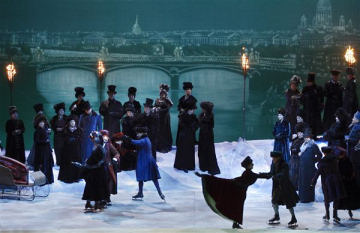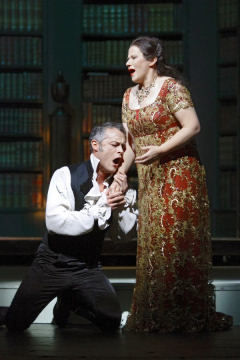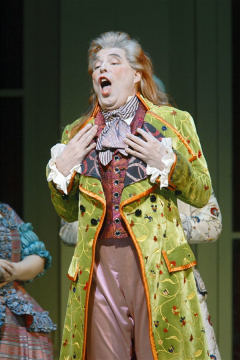|
Editorial Board
Melanie
Eskenazi
Webmaster: Len Mullenger
|
Seen and Heard Iternational
Opera Review
Tchaikovsky, Eugene Onegin: at the Finnish National Opera on 8.12.2006. Co-production with the Royal Opera House Covent Garden (GF)
Production Director’s assistant: Elaine Kidd Sets and costumes: Anthony McDonald Lighting design: Peter Mumford Choreography: Linda Dobell
Cast Anna-Lisa Jakobsson (mezzo-soprano) – Madame Larina, a widowed landowner; Soile Isokoski (soprano) – Tatyana, elder daughter of Larina; Tuija Knihtilä (contralto) – Olga, her sister; Kaisa Hannula (mezzo-soprano) – Filipyevna, the nanny; Gabriel Suovanen (baritone) – Eugene Onegin; Jorma Silvasti (tenor) – Lensky; Jyrki Korhonen (bass) – Prince Gremin, a retired army general; Lassi Virtanen (tenor) – Monsieur Triquet, a French gentleman; Tuomas Tuloisela (bass) – A Captain; Jorma Kulmala (bass) – Zaretsky, an army officer;
Finnish National Opera Choir and Orchestra/Hannu Bister
Antony McDonald’s sets for this production of Eugene Onegin (or Jevgeni Onegin as the FNO has it in transliteration of the Russian title) are definitely the most beautiful I have seen, and I have managed to catch quite a number of Onegins through the years. The seven tableaux are presented as paintings, some of them highly realistic, some colourfully naïvist, as for example the landscape in the first scene in bright story-book colours and with the peasants in red and white national costumes, singing and dancing while celebrating the harvest.
Unchanged throughout the performance is a shallow fore-stage with a door on each side. Characters move, so to speak, out of the paintings and onto this stage and, knowing director Steven Pimlott’s longstanding connection with the Royal Shakespeare Company, one can see this as an equivalent to the apron.
Before the performance and also during the overture a gigantic painting of a male nude is shown sitting crouched, forehead against knees, in a brooding position and this goes well with the sighing music of the overture, leading us into what is after all a kind of elegy. When the two sisters sing their duet that opens the play they are seen spotlit through the painting and the inventive use of lighting effects is one feature of this well-designed production. The mass-scenes are inventively handled while in the private scenes much care has been lavished on poses and positions.
Two of the paintings are special insofar as they don’t cover the full stage width but are more or less square, framed and mounted on a black wall. This is so in tableau two, showing Tatyana’s room when she writes the letter to Onegin and returns in the last tableau, when we are in the elegant room of the married Tatyana, high bookcases covering the walls. This is when Onegin comes and declares his love to her but is being turned down just as he himself had turned down Tatyana’s declaration of love, expressed in the letter.
The most spectacular scene is tableau six, which should be set in a salon in some nobleman’s mansion in St Petersburg, but through a stroke of genius has been moved outdoors and takes place at the skating rink with real skaters and an impressive view over St Petersburg in the background, dominated by the golden dome of St. Isaac’s Cathedral and, a little further away, the spire of the Peter Paul Church.
Pimlott also tries to create bridges between tableaux, to minimize the admittedly loose structure of the work, by connecting them. Thus at the end of tableau four – Tatyana’s name-day ball where the jealous Lensky challenges Onegin to a duel – he lets Lensky fall to the floor, broken down, and remain lying motionless even after the curtain has fallen behind him. When the curtain rises again and we see the bleak painting which is to be the site for the duel, he comes to life and walks into the picture.
The premiere of this production was on 24 November and it was then conducted by FNO’s new General Music Director Mikko Franck. At the performance I saw, the experienced Hannu Bister had taken over and he presented an alert and fairly unsentimental reading of the score with an uncommonly brisk and bouncy polonaise, actually played with the curtain still down as an intermezzo before “the skating rink scene”. The chorus and a group of dancers made the most of the crowd scenes in tableau one and, even more, tableau four, Tatyana’s ball. The prerequisites for a memorable evening were, in other words, ideal, even without a single word yet written about the singing.
It has to be said at once that the cast could hardly be bettered. FNO had assembled a line-up of some of the best home-grown singers, several of whom have important international careers. The great star of the evening was of course Soile Isokoski as Tatyana. She scarcely looked the 17-year-old country girl – on the other hand, how many sopranos do? – but she acted convincingly and sang with a silvery girlish timbre, expressing the heroine’s contradictory emotions in a well-rounded portrait. Her letter scene, a notoriously difficult piece to bring off, was marvellously nuanced and expressive and she of course has all the power for the big outburst. Recently, when reviewing the new recital disc with Anna Netrebko, I made a plea to the record company to consider a complete Onegin with her. I think there is room for one more, with Soile Isokoski.
As the eponymous hero Gabriel Suovanen, Swedish born but of Finnish parentage and trained at the Sibelius Academy, cut a dashing stage figure, initially singing with stern aloofness, a cold bon viveur, older than his actual age, but he gradually warmed, the first sign being a softer tone when returning Tatyana’s letter, and in the final scene, when he in vain pleads to Tatyana he offered impassioned singing of great beauty. He too is a good actor and he possesses considerable power.
Jorma Silvasti made Lensky an even weaker and more vulnerable character than usual, making his violent jealousy even more understandable. He started his big aria, Kuda, kuda, kuda vi udalilis – so softly that the first phrases were almost inaudible but he sang them with such concentration that one could almost hear the audience holding their collective breath not to miss anything. He has of course all the power needed but it was still the lyrical qualities that impressed the most.
Lyrical qualities were also to the fore in Jyrki Korhonen’s reading of Gremin’s aria. He sang it with light baritonal timbre to underline the Prince’s fragile happiness, in sharp contrast to his imposing stage figure with medals glistering from his uniform. Korhonen is certainly the greatest Finnish bass since Salminen and Ryhänen came to the fore and he descends effortlessly to the low F. In fact he has a low C, as can be heard on his BIS disc with songs by Rautavaara.
Tuija Knihtilä, whom I hadn’t encountered before, was a good Olga with fruity contralto tones, Anna-Lisa Jakobsson was luxury casting as Larina and Kaisa Hannula was an uncommonly youthful Filipyevna.
Lassi Virtanen, whom I have seen in numerous comprimario roles, made a memorable portrait of Monsieur Triquet, relishing every phrase of his couplets.
In sum then another triumph for the Finnish National Opera and it is only to be hoped that they will settle the financial crisis they are facing at the moment. The Spring 2007 offer seems sadly meagre but at least this Eugene Onegin will be played until 2 February. Don’t miss it!
Pictures © Heikki Tuuli
Back to the Top Back to the Index Page |
| ||
|
||||





